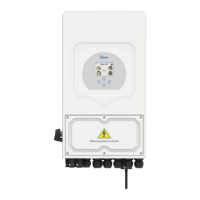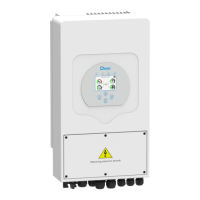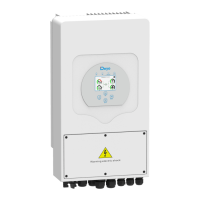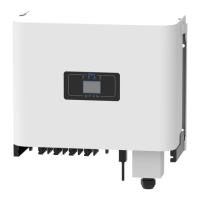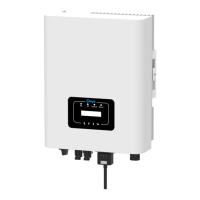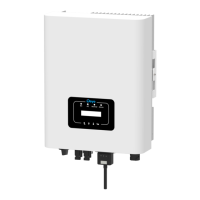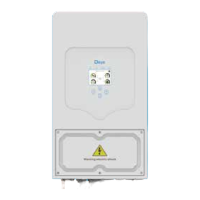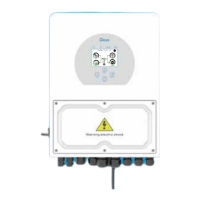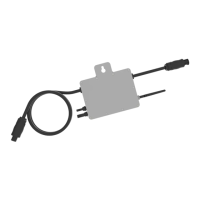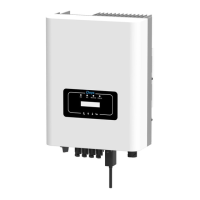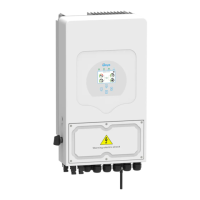
Do you have a question about the Deye SUN-3.6K-SG05LP1-EU and is the answer not in the manual?
| Model | SUN-3.6K-SG05LP1-EU |
|---|---|
| Type | Hybrid Inverter |
| Rated Power | 3.6 kW |
| Max DC Input Voltage | 500V |
| Number of MPPT | 2 |
| Rated Output Power | 3.6 kW |
| Efficiency | 97.6% |
| Battery Voltage | 48 V |
| Battery Voltage Range | 40-60V |
| Max. Charging Current | 75 A |
| Max. Discharging Current | 75 A |
| Topology | Transformerless |
| Protection Degree | IP65 |
| Operating Temperature | -25°C to 60°C |
| Output Voltage | 230 V |
| Output Frequency | 50/60Hz |
| Communication | RS485 |
| Protection | Short Circuit |
| Max DC Input Current | 13 A / 13 A |
| Peak Output Power | 7.2kW |
Covers warning symbols and general safety advice for inverter operation.
Instructions on how to read and use the manual for proper operation.
Provides a detailed overview of the inverter's front and rear panel components.
Details the physical dimensions and specifications of the inverter.
Lists the key features and capabilities of the hybrid inverter.
Illustrates the typical system configuration and connection of the inverter.
Lists all the components and accessories included in the inverter package.
Provides guidelines and precautions for safely mounting the inverter in suitable locations.
Explains the necessary steps and components for connecting the battery to the inverter.
Defines the purpose and connection of different functional ports on the inverter.
Details the procedures for connecting the inverter to the grid and backup load.
Explains how to connect the PV modules to the inverter, including cable size recommendations.
Describes the connection procedure for Current Transformer (CT) sensors.
Emphasizes the mandatory grounding requirements for safety.
Information regarding the optional Wi-Fi plug and its configuration.
Illustrates different wiring diagrams for various system configurations.
Shows the application diagram for integrating a diesel generator with the inverter.
Provides the wiring diagram for single-phase parallel connection of multiple inverters.
Details the wiring diagram for three-phase parallel connection of inverters.
Describes the procedure for turning the inverter unit on and off.
Explains the function of the LED indicators and function buttons on the inverter panel.
Explains the information shown on the main screen and its interactive elements.
Illustrates the navigation flow for operating the inverter's LCD interface.
Shows how to view and interpret daily, monthly, and yearly solar power generation curves.
Details how to check solar, load, and grid power curves on the LCD.
Covers settings for time synchronization, beep, auto-dim, and factory reset.
Allows configuration of battery type, capacity, charging, and discharging parameters.
Configures the inverter's operation mode, such as selling first or zero export.
Enables adjustment of grid parameters like mode, frequency, voltage, and protection settings.
Guides through the process of performing the CEI-021 standard self-check procedure.
Details how to configure the generator port for various operational modes and settings.
Provides access to advanced functions like Solar Arc Fault, DRM, and Gen Peak-shaving.
Displays inverter ID, firmware versions, and alarm codes.
Illustrates the basic system configuration with solar and battery.
Shows the system setup including a generator for power supply.
Depicts the system configuration incorporating a smart load function.
Illustrates the system setup for AC coupling with another inverter.
Provides guidance on identifying and resolving fault messages and errors.
Outlines the company's limitations of liability regarding product warranty and usage.
Presents detailed technical specifications and parameters of the inverter models.
Details the pinout definition for the RJ45 port used for BMS 485/CAN communication.
Provides the pinout definition for the RJ45 port used for RS 485 communication with meters.
Explains the RS232 port usage for connecting the Wi-Fi datalogger.
Provides the dimensional specifications for the split core current transformer.
